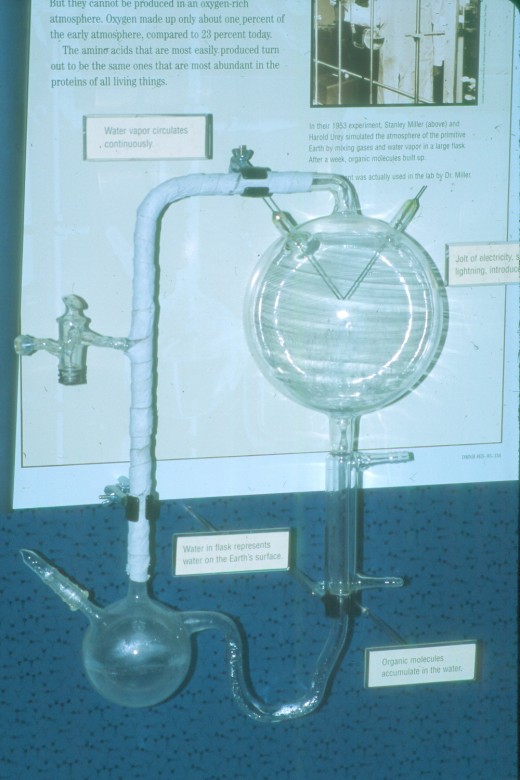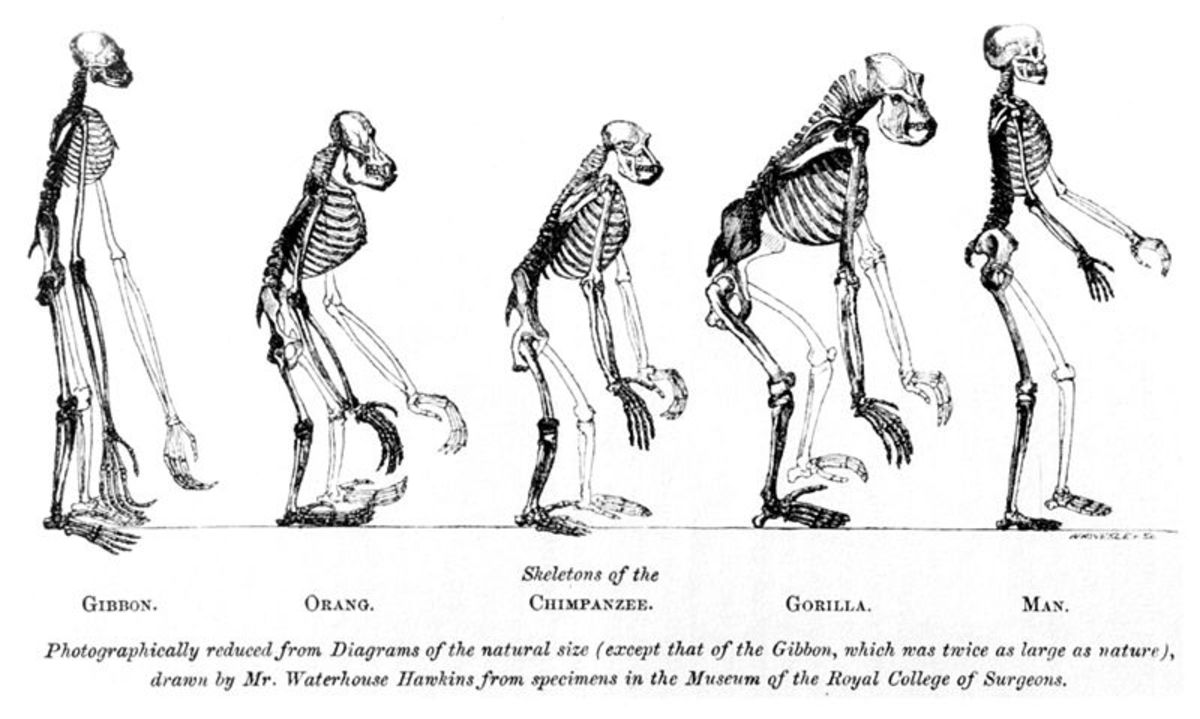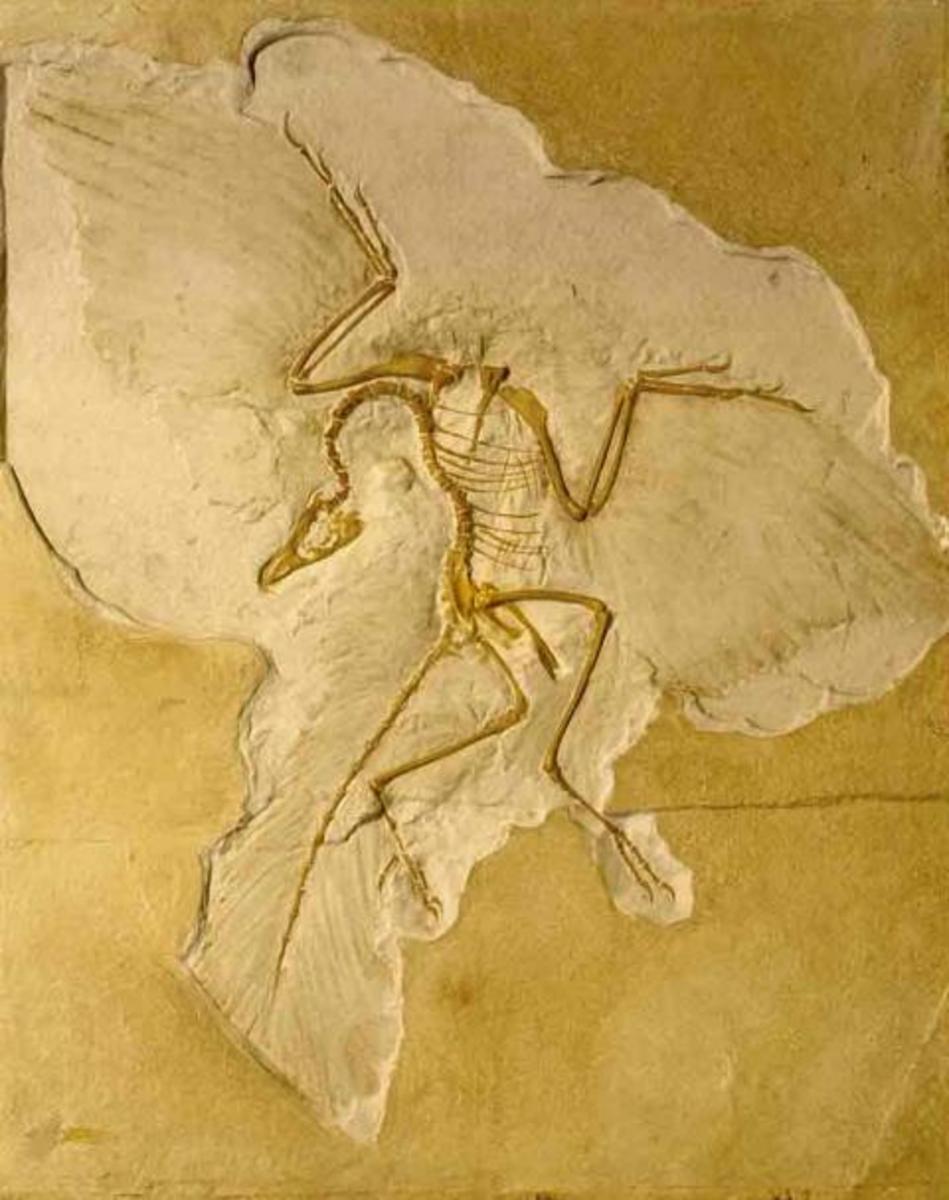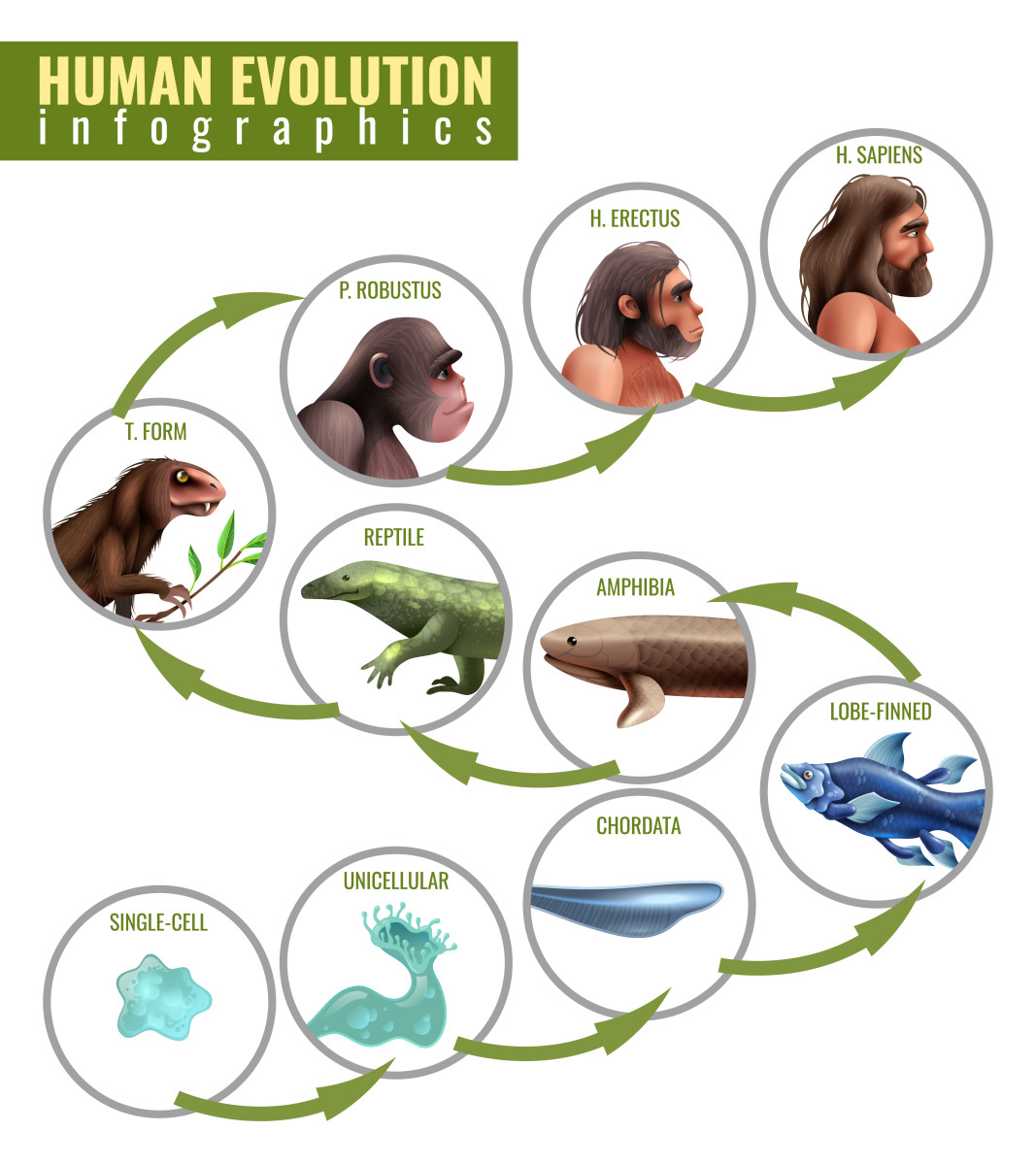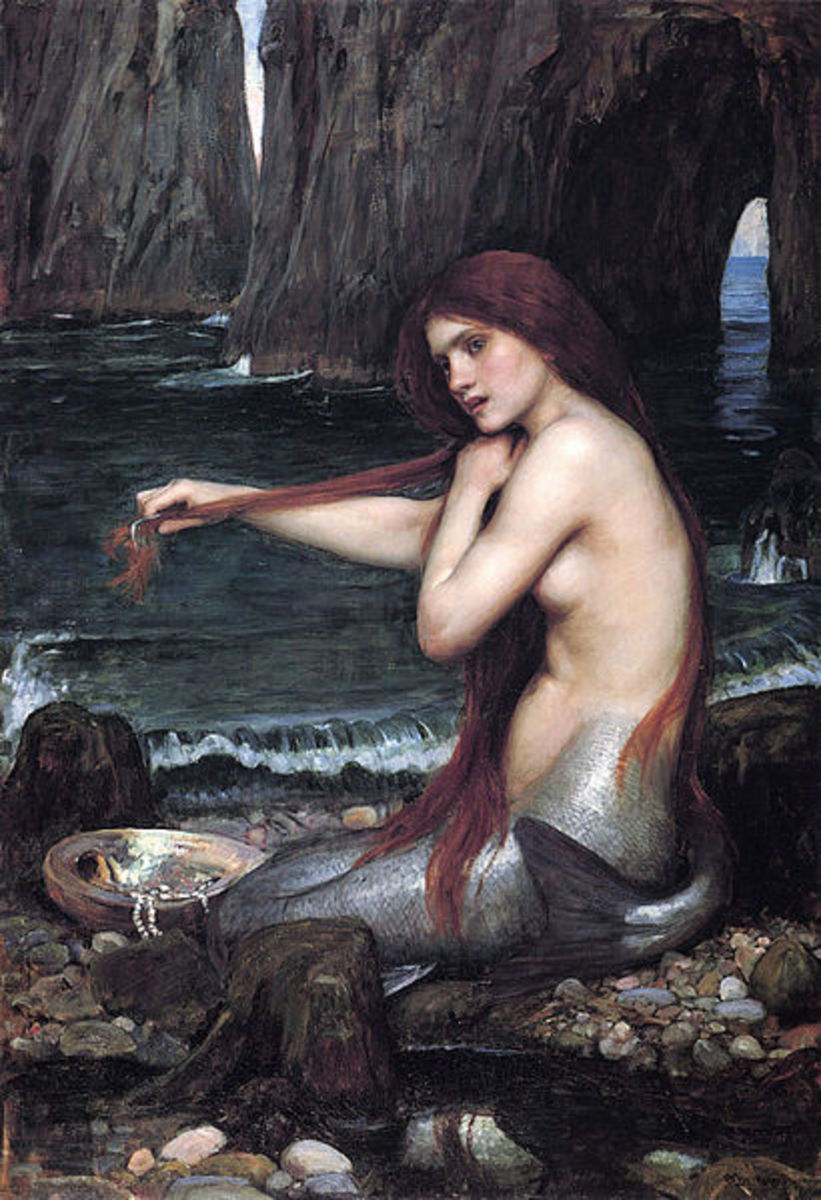EVOLUTION PLAIN AND SIMPLE (Part III)
DEFINING EVOLUTION
EVOLUTION, PLAIN AND SIMPLE
By Robert George Sprackland, Ph.D.
© 2001, 2003, Robert George Sprackland, Ph.D.
Defining Evolution
Paradigms are points of view - What scientists mean by "theory" -
The origin of life - How evolution is about genetic "edits" -
Not all genes are good, and we use some of the "bad" ones -
The universal properties of life - Evolutionary theory is science, not ethics or religion
"What's the name of the man on second."
"I'm not asking you who's on second!"
"No, who's on first."
"I don't know."
He's on third-we're not talking about him."
When Bud Abbott and Lou Costello came up with their wonderful skit, "Who's on First," they did a great deal to provide depression-era America with something to laugh about. The skit, made famous on radio, cinema, and TV, is a classic example of how a paradigm shift works. Poor Costello takes the "names" of the players wrong; Abbott told him they have "crazy names," but Lou can't grasp using "Who" as a personal name for a first baseman. We, of course, immediately see the double interpretation, and thus see "reality" from the perspectives of Bud and Lou.
In many discussions about complex subjects, such as evolutionary biology, people may have a conversation in which two paradigms are active, much as in "Who's on First?" To someone who sees "theory" as a vague will-o'-the-wisp idea, a discussion based on the foundations of a theory will seem rather contradictory. To the scientist, however, "theory" means an idea that has stood considerable rigorous testing, and is as demonstrable as modern techniques to investigate will allow. Add to that the considerable confusion that reigns over the word "evolution" itself. To one person, it refers to a change in a population at the genetic level; to another, it means nothing less than turning apes into human beings. To a third observer, a discussion between two such people would be a bit like listening to "Who's on first," each person seeing a very different paradigm.
Having covered the history of evolutionary thought, I now turn to describing the scientific description of what is meant by "evolution." In doing so, it will be necessary to explain what scientists mean by "theory," and how no theory in science is responsible for human ethics. All of these subjects are important if we are to understand what evolution is, and what it is not.
To begin this section, I want to begin by pointing out that Darwin never used the word "evolution" in On the Origin of Species, though the very last word in the book was "evolved." Instead, the phrase of choice was "descent with modification," implying that organisms change over time. "Evolution" has subsequently come to represent the overall concepts of Darwin's descent with modification coupled with variation due to genetic mutation. Among those people least educated on this subject, "evolution" has come to mean "monkeys turning into humans." This last definition is without merit.
For many people, evolutionary biology has been coupled with the subject of the origin of life itself. The origin of life is a subject within the realm of biochemistry, dealing as it does with how chemicals combined and reacted to form the precursors for, and eventually structures of, life. Volumes have been written on this subject by authors far more familiar with the intricacies of chemistry than I, but a few facts concerning what is known about the subject are important. Therefore, I shall now present an overview of the best scenario science has developed concerning the ultimate mystery that haunts us all at one time or another-the origin of life on earth.
In the Very Beginning
Early students of the subject of life's origin believed that a small pond, illuminated by sunlight, initiated the chemical processes that we would recognize as very simple life. This allusion has been called "Darwin's dream pond," and persisted as a workable hypothesis for over a century (Goldschmidt, 1996). During the mid-twentieth century, the Dream pond evaporated as a Russian organic chemist, Alexander Oparin, did a comparative study of the atmospheres of our neighboring planets. He noted that all were rich in ammonia, methane, and carbon dioxide, with a tiny trace of water vapor. This chemical combination would produce what chemists know as a "reducing" atmosphere. Oparin reasoned that if all the planets in our solar system formed from the same original accretion mass, then the early earth should have had an atmosphere similar to that of the other planets. How, then, did earth's atmosphere change into an oxygen-rich "oxygenating" atmosphere? It was a by-product of life, and occurred millenia or eons after the earth formed, or so Oparin believed. This line of thought is known as Oparin's hypothesis. A hypothesis, in science, is an idea based on some observations and can be subjected to testing. In short, what most people call "just a theory" is what a scientist calls a hypothesis.
There the matter rested until the 1950s, when a lecture about Oparin's hypothesis by Nobel laureate Harold Urey inspired one of Urey's graduate students to put the hypothesis to a test. In 1953, Stanley Miller became the founder of origin of life experimentation by conducting a simple experiment. In a specially built flask, Miller added the gases that Oparin supposed would have been in earth's early atmosphere. A system needs an energy source to initiate chemical reactions, so Miller used one of the commonest atmospheric energy sources-lightning. Actually, he fired electric currents into his primordial soup. What happened next has become almost legendary.
Miller collected samples of the liquid that formed in his flask during his experiment, and found that it contained several amino acids. Amino acids are simple chemical molecules that make up the more complex proteins, the stuff which makes living things. All living things are made up of only twenty types of amino acids, and Miller's experiment produced several of these chemicals in less than two days.
A few points to note: first, the most basic and essential building blocks needed to build a living thing were assembled in a small laboratory beaker in less than 48 hours. Second, the experiment used only a very few of the many kinds of chemicals that were actually present on the early earth. Third, Miller used only one of several possible sources of energy to run his experiment. This means that had only a very few basic chemicals been present on earth some 3.8 billion years ago, and they had been effected by only a single source of energy, the basic chemicals needed to build a living cell would be present within 48 hours. In reality, the early earth was (and is) much larger than a small lab flask, contained thousands more chemicals than used by Miller in 1953, and was (and is) subjected to many sources of energy, including lightning, solar radiation, geologically-generated heat, and so on.
For the following fifty years, many labs and many scientists have sponsored many experiments following up on Miller's initial work (Miller himself continued this work well into the 1990s as head of Biochemistry at the University of California, San Diego). The results have varied from interesting to spectacular, with the formation of additional amino acids, simple proteins, and even cell-like structures. Though experiments can produce a variety of important biological chemicals, no one has yet produced "life in a test tube." Perhaps the missing ingredient is simply time (it may have taken hundred, thousands, or a few million years to go from precursors to the first cells), but we do not yet know. Meanwhile, the chemists continue to experiment. So far, the experiments always yield the building blocks of life within a few hours. This is an extremely important point to keep in mind when so many critics claim that the chemistry for life is too rare or improbable to have come together without supernatural influence.
One implication of the Miller and subsequent experiments is that Darwin's dream pond has been replaced by an inhospitable sea of ammonia on an extremely hot (not warm) planet. Any life that would result from Oparin's environment would be quite physiologically different from familiar living things we see today. To them, oxygen would have been a terrible and corrosive poison, and they would have needed carbon- or sulfur dioxide gas the way we need an oxygen-nitrogen air. These drawbacks were seen by many as strong arguments against Oparin's hypothesis having validity as an explanation to life's origins. That is until the discovery of a wide range of organisms alive today that still find oxygen to be a deadly gas. These creatures are primarily single-celled bacteria and bacteria-like organisms called archaebacteria. Some live in water that exceeds the boiling point, others live in sulfurous places near volcanoes and geysers; some die if even briefly exposed to air, and recent discoveries have found bacteria that come from deep underground. It is no longer science fiction to ponder creatures that would live on Oparin's early earth.
How, then, did the atmosphere change to its present configuration? The present hypothesis tells a story of organisms containing chloroplasts, the energy producing structures in the cells of plants and many single-celled organisms. These structures use sunlight to convert inspired carbon dioxide into sugars and the toxic by-product oxygen. Over the span of hundreds of millions of years, the residual oxygen pollution produced by these organisms shifted the molecular composition of earth's atmosphere. At some point, oxygen levels reached toxically high levels, causing a major extinction event that left only a relatively few oxygen-tolerant species to survive and repopulate the planet. From those survivors came almost all life on earth as we now know it, including us. (See also Jones, 1999- Darwin's Ghost: the Origin of Species Updated. Random House; Mellersch, 1994- The origin of life. Natural History 103(6): 10-13; Niklas, 1994- One giant step for life. Natural History 103(6): 22-25.)
Modifying Our Descent
Heredity has profound effects on both biological and cultural descent. It was heredity that left Elizabeth I to rule England in the latter 16th century, and her failure to produce children of her own that forced the throne on the son of her cousin, Mary, Queen of Scots. The son never met his mother, indeed was taken from her within weeks of his birth. In time, Elizabeth was moved to make Mary one of the most famous and revered of martyrs. Heredity was to make the now adult son one of the landmark monarchs in the royal history of Great Britain. He became King James VI of Scotland and, after Elizabeth's death, King James I of England as well. He thus became the first monarch of England, Wales, and Scotland (though formal union of Scotland and England into a Great Britain would come in the next century), and in so doing changed the hereditary monarchs from the Tudor to the Stewart line. This hereditary consequence would also take Britain away from its relatively religiously liberal Elizabethan model and usher in yet another intolerant age of religious persecutions.
As part of James's reign, he ordered the writing and publication of a standard English language version of the Bible. Though he did not write the book, his name remains firmly engraved on the King James Bible. The efforts behind the making of that Bible serve as an excellent example of how genetic evolution works in our cells.
We have to go back to much earlier versions of "The Good Book," long before it appeared in English or Latin. As an exercise in a Latin course, I was once required to translate part of the Genesis story from the Vulgate Bible. To my amazement, it opened with the words: "In the beginning of all were the words of the gods." While I cannot offer a first-person account of earlier versions in Hebrew or Aramaic, I am convinced that they, too, had interesting and, by today's standards unorthodox, accounts of what happened. Considering that all early copies of the books were individually hand-written, it is also not too big a stretch to suggest that many discrepancies-be they minor and typographical or more substantial versions of a particular story-could be found among different copies of a particular "edition" of a Greek, or Aramaic or even Latin Bible.
Now move along into the Europe of the 13th through 16th centuries, in fact up until shortly before Elizabeth I became queen. Irish monks in the secluded monasteries produced many Bibles as a relative cottage industry. Few monks could read the words; they just did artwork that "happened" to be text. Any particular monk was extremely unlikely to write a whole book, but instead would do only certain sections. These sections would be collected and collated by an "editor" monk and assembled into a complete text. Without the benefit of Herr Guttenberg's printing press, it does not take any great leap of faith to assume that Friars Xerox and Ricoh would, over time, produce slightly different versions of the "same" text. The very best of the scribes may nevertheless be correctly copying errors produced by the authors of the versions from which they made their copies. After all, someone passed out the editorial pink slips to reduce "the gods" of my Latin Vulgate to the more familiar "God" (singular and big "G") that much of the western world accepts today. So if Friars Hewlett and Packard inserted errors into master texts later used by Friars Xerox and Ricoh, the latter version would compound the number of errors over those in earlier editions. These failures in the editing process are transcription errors, and the same situation is seen in the copying of genes (It is interesting to note that linguists are using precisely these typographical errors to trace the lineages of medieval illuminated manuscripts). (For more on this fascinating subject, see Ehrman, 2005- Misquoting Jesus. Harper, San Francisco.)
In neither case are errors introduced intentionally, though the mechanisms are quite different. Friar Ricoh may have had a bad day, or Brother Packard may have let his mind wander and thus linked the end of one line to the incorrect beginning of another. How many times have you flipped a page of a novel only to find you are reading three pages ahead because the paper of the intervening two pages stuck together? Although DNA is subject to chemical modifications, its variations are similarly mindless, and will slowly accumulate enough changes to cause a very different reading from a very early edition.
Even Guttenberg's great invention (which had been used by the Chinese for more than 2000 years) did not eliminate transcription errors, though they were significantly reduced. Typesetting eliminated one type of error but allowed the introduction of new types of error. So, too, in DNA. The transcriptional editors modify to reduce certain kinds of mutations, while other problems take their place. Humans of 2003 face many mutagenic (DNA modifying) factors, such as nuclear radiation, increased solar radiation due to ozone depletion, and many toxic chemicals that earlier generations never even considered. What happens to the DNA in our cells is not all that different from what has happened to the many iterations of the Bible.
Life, having somehow started, immediately was challenged by its environment to survive. From that first archaeoprimordial cell to the present, all organisms have been faced with three options in dealing with that environment: evolve, move, or die. Evolving is something that is done by a population or a species, not an individual. Success as a species is dependent upon the population's ability to modify itself as the environment changes. Moving is often only a temporary solution, but is frequently employed. To die as a species is to face extinction, the fate of the overwhelming majority of life forms that ever graced the earth.
As I've pointed out already, all that is required for evolution to take place is to change the proportion of genes or alleles within a population. Consider an example that might make a bit of sense relative to things with which we are all familiar. Let the letters AET represent a sequence of nucleotides, the chemicals coded for by DNA and which are the products of our genes. There are two forms that they can take that are obviously related: EAT and ATE. In genetic terms, they would represent two possible forms, or alleles of a gene. But switch the order into TEA and a completely new meaning takes place, having no direct relationship to the functions of "EAT" or "ATE." If all the organisms with this gene had only two alleles (EAT and ATE), then an organism with the new sequence TEA would represent a mutation (that is, the sequence was not inherited from either parent, but arrived as a novelty). If that mutation manages to survive in the organism, then TEA could become a new allele with a radically different function than its two predecessors. If TEA offers some advantage to an organism carrying it, it is likely to survive (as predicted by natural selection theory). If it confers a disadvantage, it is likely to become very rare or eliminated from the population (also per natural selection). Most often though, a mutation is expected to have no appreciable effect on an organism, and thus persist even if not or but rarely expressed as a phenotype (neutralist theory of gene mutation). Let me offer a real example.
Human red blood cells (erythrocytes) are normally disk-shaped structures with smooth sides-they look something like a Frisbee. In the sickle-cell condition, the cells fold into a boomerang-shape, with pointed edges. These sharp edges can lodge in small capillary walls and cause obstructions of blood flow, usually painful and often fatal. People with only normal cell alleles (let's call them "ss", one "s" inherited from each parent) have healthy blood, while those with defective alleles (s's') have sickle cell anemia. As it happens, the alleles are codominant, so that a person with both types of allele (ss', a heterozygote) will produce both types of blood cell. Why would an allele for a largely fatal disease survive in human populations?
The answer is that people who are heterozygous (having one of each allele, i.e. s's) for the condition have a greatly increased resistance to malaria, one of the major killing diseases in tropical countries. People in such areas that lack the allele tend to die of malaria, while those homozygous (s's') for the trait die from sickle cell anemia. In these environments, selection favors the heterozygote, giving the person both normal blood cells and some immunity to malaria, thus keeping both homozygote lines (s's' and ss) alive, at least long enough to produce children. This also explains why the allele for sickle cell is so much more common among people of African, Indian, and Asian descent, coming from high malaria risk regions, than in Europeans or Inuits.
The sickle cell allele is interesting for another reason: it shows how minor a change might be that can cause a great phenotypic (observable) effect. The hemoglobin in humans is made from four protein strands, each coded by a different gene of about 130 nucleotides each. It only takes a mutation in one of those nucleotides to build the sickle cell protein; that is, a change in one out of about 500 bits of DNA code!
At the more extreme level of change, a species may give rise to a completely new type of organism that is also a species. This process is called speciation and has been the main focus of evolutionary study since long before Darwin. Two problems have attended this research. The first is that speciation is generally regarded as a slowly occurring process, at least by human standards. While zoologists have many cases of "incipient species"-varieties or "subspecies" en route to becoming new species-no one knows when a speciation event will occur. The second problem is that biologists have not yet been able to develop a universally accepted definition of just what a species is. This second problem is so significant that it is addressed separately in the next chapter.
What is a Theory?
It is unfortunate that a term with such pivotal importance to science also has a popular definition that is an antonym. To a scientist, a theory is defined as a body of observations and facts that have withstood vigorous testing without invalidating the basic premise being examined. Unlike the vernacular definition, a scientific theory is a well-founded, well-supported idea supported by a variety of subordinate ideas. It is not a wild guess or mere assumption.
Sadly, evolution is frequently presented as "just a theory" by lawyers in cases that try the legality of teaching evolution in U. S. public schools. Lawyers produce legal documents that often include lengthy glossaries defining terms in excruciating detail. For example, an apparently obvious term such as "The Company" may be defined in a contract as "the organization incorporated as Acme Co. and empowered to act as an employer for the terms of this contract, allowing for negotiating, modifying, approving and enacting a legal contract on behalf of said Company with the contractor." Nevertheless, lawyers still present evolution as "just a theory," giving no credence to the specific and scientific definition of that term. This is hardly surprising considering that law and science use very different criteria and methods to obtain and evaluate what they consider facts. The "just a theory" of most people is the hypothesis of a scientist. Many of us recall the definition of hypothesis from 7th or 8th grade science class as "an educated guess." Of course, there is little agreement on just how educated that guess must be, or even where the guess was educated! Still, leaving problems of grammar and syntax aside (a terrible thing to do when dealing with definitions), a hypothesis is merely a guess or, better yet, a prediction. It must be possible to phrase a hypothesis as a question. For example, the statement "When dogs eat grass, it's going to rain" is a hypothesis, and can be rephrased into a question (thus making it possible to confirm or deny) as "Does it rain when dogs eat grass?" (Of course we my get a situation where we observe rain within a few hours of seeing a dog eating grass, which would lead a good scientist to proceed with another hypothesis to see if there is really a cause-effect relationship, i.e. "does a dog eating grass cause/influence the coming of rain?")
Now to bring the argument back to evolution. Let's start with a hypothesis, "organisms evolve over time," which can be rephrased into a testable question as "Do organisms evolve over time?" We can observe a population in nature or in a laboratory, measure certain characteristics (as did Mendel with pea plants), and compare the proportion of characters after a given number of generations. Recall that the most basic definition of evolution is "a change in the frequency of genes or alleles in a population over time." If we observe that our predominantly green pea pods in time yield gardens with predominantly yellow pods, then evolution has indeed occurred. Is evolution at this point a theory? No, because no single test by itself can constitute sufficient evidence. After all, if we don't know much about genes, we could easily explain the event by other mechanisms. Perhaps the amount of sunlight bleached the pods, or something in the soil causes color change without affecting the "nature" of the plants.
So we can expand our search to look at the genes. We can detect a certain percentage of alleles in the "before" population and compare that with the percentage in the "after" population. If the numbers changed then, by definition, evolution has occurred. Can we now move evolution to theory status? Preferably not; further examples and corroboration of change mechanisms are desired.
The next step, then, is to look at genetic patterns in other organisms. Let's say we've been able to link some traits to particular genes in butterflies, guppies and magnolias. Each population we observe changes over time, and follows Mendelian-derived principles. We now have four examples following the same principles and patterns, such that we can start to look at evolution as a theory. We find further corroboration from chemistry (that is, no chemical principles are violated).
To truly bolster our tentative theory, we want to find evidence that the observed changes are indeed genetic and not products of ecology or non-genetic variation (such as changing skin color dependent upon exposure to sunlight, or the fur color of some rabbits which is based on temperature variations). As we eliminate alternative possibilities for observed changes, our theory gains greater validity.
After studying biological diversity for over 150 years, evolutionary biologists can now unequivocally state that evolution is a fact, based in large part upon such observed evidence as:
•1. The universal presence of DNA in all living things. (Viruses, which may possess DNA and may do some things similar to "life," but are non-living.) No living thing on this planet does not have DNA.
- 2. DNA is universally found in living things is "right handed," though it would be statistically as easy for it to be "left-handed." No known life form has left-handed DNA. (To understand this, think of DNA as being built like a very tiny spiral staircase. If, as you go down the stairs, you keep turning to the right, going clockwise, then you are imagining a right-handed structure.)
- 3. The structure of DNA is universal, made of four, and only four, identical nucleotides (adenine, guanine, cytosine and thymine). A gene from a human can be placed into and read by a bacterium, and a tobacco cell can read a gene from a firefly. This was dramatically demonstrated in the 1970s when geneticists transplanted some genes from a firefly into a tobacco plant, producing a plant that glows in the dark! For over a decade, biologists have been inserting normal "insulin-producing" genes into bacteria and harvesting the human insulin they produce so it can be given to human diabetics. There is no difference in DNA among living things, only in its sequences and the way it is contained (or "packaged") within cells.
- 4. DNA universally codes for polypeptides (or proteins, a matter of chemical semantics), the living stuff that makes up an organism. Not only does DNA provide the blueprint for proteins, but no other chemical performs this task.
- 5. All polypeptides in living things are left-handed.
- 6. Genes made of DNA universally govern inheritance in all living things. With each generation, some difference, usually minor, is made in the DNA code, resulting in mutations or recombinations.
- 7. Allele frequencies in populations regularly and routinely change over time, a process termed "evolution." Such processes explain developed antibiotic resistance in bacteria, the regulation of plant height when grown in different soils, and the variation in skin pigment relative to a human population's distance from the equator.
Why, then, is evolution not elevated to the status of a scientific law? After all we have laws of thermodynamics, laws of motion, laws of planetary orbits, so why not a law of evolution? It is simply because biology is the science of exceptions, and no two organisms (or, if you prefer, biological systems) will behave exactly alike no matter how identical their environments. Living things are the true embodiment of complexity theory (the mature version of "chaos theory"). We can predict that organisms do change and that they change, but not what they will change into or specifically what will induce such change. Evolution is thus a theory, probably the most thoroughly supported theory in science, but limited to theory status. If there is an evolutionary law at all, it must be simply this: change happens. Otherwise, perhaps we would best serve science by using a new term and claiming simply that evolution is a fact.
What Evolutionary Theory Cannot--and Does Not--Do
From the time of the publication of On the Origin of Species, many people felt very strongly that if evolution were proven true, it would mean that the qualities we associate with "goodness" and "ethical" would somehow be rendered irrelevant. Without a narrow belief in God and a fear of Hell after life, these people believe, humans have neither the guidance nor intrinsic motivation to be "good," and society would rapidly decay. If the hand basket were no longer going to Hell, it would at least ferry us through a Hell on earth. What many scientists do not realize is that the most vociferous opponents to evolutionary theory among the Christian extremely far right is that they fear the ascendance of the theory of evolution means an end to the bedrock on which their ethics are built. I argue--strongly--that nothing could be further from the truth.
Thomas Huxley noted this concern among evolution's detractors, and expressed his opinion that fear of a supernatural god need not be the only reason people have for ethical living. His own belief in the God of his Anglican roots was severely shaken by a variety of factors. As a scientist, he claimed, he must be as objective as possible in accepting or denying any bit of data. To a scientist, a beautiful truth may, he claimed, be dashed by an ugly fact. Since he knew of no objective criteria by which to determine the existence or non-existence of a supernatural deity (which, by definition was beyond "natural" means of observation), Huxley chose a new term to describe himself: agnostic. Coming from the Greek term meaning "I don't know," Huxley's emphasis was on "knowing" over "believing." Humans, he felt, could not objectively know whether or not God existed. Of course, such an honest proclamation was used to label him an atheist because then, as now, most people did not understand the differences between the words "believe" and "know." But even here Huxley stood morally firm. He could not be an atheist he said, because while he did not know if there was a god, he also did not know there was not. Critics, of course, were not satisfied, and Huxley became an object of ridicule by religious hard liners.
How morally corrupt was this "Devil's disciple," as he was labeled in the press? Huxley championed free education for the working class, and taught night school for many years. He actively promoted universal public education, and education for girls. He supported women's suffrage and the advancement of charitable organizations. Huxley was also a major force in establishing science as a career, rather than an interesting pastime for the wealthy or for clerics with time on their hands. He was also a faithful husband, good father, and ardent family man who had to pawn his coveted Royal Society gold medal to help pay his alcoholic sister's bills. A person could do far worse than emulate Huxley as a role model. I seriously doubt he was (or is) the only godless man who lived such a strongly ethical and moral life.
But evolutionary theory was not used by Huxley to justify "eminent domain" or any of the excesses of "social Darwinism." Evolutionary theory is not about, and should not be used to support, any ethical, moral or social situation. Evolution does not teach about "good" or "bad" any more than does atomic theory. It is about "what is," and not about value judgments. A lion killing a zebra for food is neither bad nor evil; it is simply following its nature and eating. When we have a chicken dinner, we are not murderers, but living animals feeding. The alternative is not eating, and thus dying. (Vegetarians should note that plants are also living things, and if you eat them, you are killing to stay alive; abstention from eating animals is merely drawing a line you can live with, but does not reflect some "great truth" about not killing to eat.)
Evolutionary theory can tell us how to combat infectious disease; it cannot be used to tell us who gets treatment and who does not. Blaming evolution for this inability to tackle moral issues is unwarranted; it is like blaming your car for being unable to cook your dinner. The one has no relationship to the other. Those seeking morality in evolution are bound to be disappointed, for evolution is not about morality. Making claims about the theory's veracity or importance based on this yardstick is to completely misunderstand both the role of science and the nature of morals.
Dr. Robert Sprackland is an evolutionary zoologist and college anatomy, physiology, and biology instructor. Hs newest book, Giant Lizards, 2nd Edition, is scheduled for release in October 2008.
